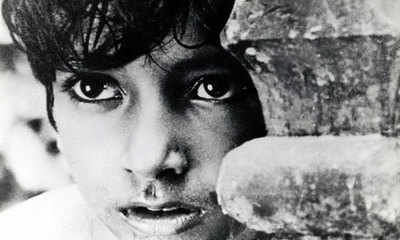- News
- entertainment
- bengali
- movies
- Is Bengali cinema losing its plot in the national context?
Trending
This story is from September 1, 2015
Is Bengali cinema losing its plot in the national context?
At a time when international recognition eludes Bengali cinema; not one film from the region has made to the Oscars as an official Indian entry after Satyajit Ray's Mahanagar. Is Bengali cinema losing its plot in the national context?

At a time when international recognition eludes Bengali cinema; not one film from the region has made to the Oscars as an official Indian entry after Satyajit Ray's Mahanagar. Is Bengali cinema losing its plot in the national context?
In the '60s, Columbia Pictures came calling on Satyajit Ray. They wanted him to make a science fiction and Ray got busy writing the story of Mr Ang, an alien of the size of a thumb, loosely based on his own Bankubabur Bandhu.Script of The Alien, set in the fictitious Mangalpur in rural Bengal, had an American engineer and a Marwari businessman; every other character was Bengali. While describing a scene from the screenplay, Ray's biographer W Andrew Robinson wrote: ���In a series of fantastically quick, short steps over the lotus leaves, the Alien reaches the shore of the pond. He looks down at the grass, examines the blade and is off hopping into the bamboo grove. There the Alien sees a small plant. His eyes light up with a yellow light. He passes his hand over the plant, and flowers come out. A thin, soft high-pitched laugh shows the Alien is pleased.��� That the film didn't happen is another story . Even before that, Ray had refused another offer by David O Selznick, the producer of Gone with the Wind. A name to reckon with, even in the international circuit, Ray faced several hurdles before making a cut with Pather Panchali-which completed 60 years of its domestic release on August 26. His own stories of struggle are now part of cinema's history . And today, history too defined around the film -pre and post-Pather Panchali.
WAR AGAINST MEDIOCRITY
Much before Ray forayed into cinema, he would write a column with a popular daily as a cover artist, illustrator and book designer. There, he wrote about his apathy for Bengali films with mindless plots and actors donning the greasepaint to be part of cinema that had no roots. Said Ray scholar Ujwal Chakraborty , ���He thought it was important to show what he firmly believed in and Pather Panchali, based on Bibhutibhushan Bandopadhyay's novel of the same name, happened. Ray, who had mortgaged his wife's jewellery, pawned his life insurance policy and sold his gramophone records, was finally sanctioned a loan by Bidhan Chandra Roy, the then CM of Bengal. The government thought it was a docu for rural uplift, and recorded the loan as that for `roads improvement', a reference to the film's title. When American filmmaker John Huston saw the silent rushes of the film in Kolkata, he immediately shot a letter to the Museum of Modern Arts for its screening. The film ran for seven months in New York and there was no look ing back.��� And it was nostalgia all the way as Aparna Sen, Dibakar Banerjee, Dileep Padgaonkar, Nandita Das, Sharmila Tagore, Shoojit Sircar, Sujoy Ghosh and Suman Mukhopadhyay , along with moderator Dhritiman Chatterjee, got together to debate on Indian Cinema: What is national, what is regional, on Sunday morning. The focus of the seminar organized by the Society for the Preservation of Satyajit Ray Archives, apart from Pather Panchali, was on why regional cinema is often perceived as a poorer cousin of Bollywood by th0 national audience.
The popular saying is that cinema knows no language barrier. But in reality, Hindi has more acceptance in the country and is, therefore, a more popular means of communication. Hindi cinema, needless to say , caters to a larger audience. Sujoy , who recently made waves after releasing his short film in Bengali, Ahalya, on the net, however thinks differently.���If people can watch a Korean, Japanese or a French film with subtitles, why not a Bengali movie? While watching
WHERE'S THE MONEY FOR MARKETING?
The biggest constraint while releasing a Bengali film outside the state is the lack of publicity budget. Nandita, who has worked in several languages, is not in favour of branding cinema as national or regional.
���The nexus between producers and distributors is so deep that they assume a regional film will not do well outside the state. Some of my better works are in films that not many have seen. There was a choice if I would compromise on my acting skills in a Hindi film or do movies, which, when archived, live forever. I chose the latter,��� she said. Suman thinks cinema today is indeed driven by the economics.���Court (Marathi) ran for a couple of weeks in just one theatre in Kolkata. On the other hand, Masaan, a Hindi film, thanks to great support by its producers, is still running. We are unable to create a separate distribution channel for regional cinema.���
NEED FOR SUPPORTIVE PRODUCERS
Aparna said there were offers to make Mr and Mrs Iyer in Hindi, but she refused as one of her characters is Bengali and the other, Tamil. ���Why should I do that? It's very important to have producers who have complete faith in your vision,��� said the actor-director, who feels more than the national-regional divide, what is worrying is the binaries created within the region.
���Today, Bengali cin ema is faced with a great urban-rural divide.Overcoming that is a huge challenge,��� she said. Shoojit, who tasted success as the producer of Open Tee Bioscope, a Bengali film, echoed similar feelings.���It's impossible to make it big without the support from producers. There was a time when a National Award-winning Bengali film would release at an art centre; it was thought to be art film. There was something wrong in catering the film to the audience,��� he said.
ALL ABOUT CONVICTION
Sharmila, who worked in many of Ray's movies said there's reason why the master filmmaker managed to transcend all barriers -be it topographical or that of language. ���He never let style override content. That's why a film like Aranyer Din Ratri still remains so contemporary . Ray is transnational, he is global...��� she said. Dibakar feels it's important that a film has an audience base in its own region. ���To fight with Bollywood, it needs to have support from its own people. But often, regional cinema is perceived as a poorer cousin of Bollywood.See, Ray stuck to his own language, own region, spoke to less number of people and didn't go for a wider audience. In the near future, I see regional films standing out as true human documents than the homogenized Bollywood.��� Pather Panchali was honoured with the Best Human Document award at the 1956 Cannes Film Festival. That it continues to inspire is a story in its own.
In the '60s, Columbia Pictures came calling on Satyajit Ray. They wanted him to make a science fiction and Ray got busy writing the story of Mr Ang, an alien of the size of a thumb, loosely based on his own Bankubabur Bandhu.Script of The Alien, set in the fictitious Mangalpur in rural Bengal, had an American engineer and a Marwari businessman; every other character was Bengali. While describing a scene from the screenplay, Ray's biographer W Andrew Robinson wrote: ���In a series of fantastically quick, short steps over the lotus leaves, the Alien reaches the shore of the pond. He looks down at the grass, examines the blade and is off hopping into the bamboo grove. There the Alien sees a small plant. His eyes light up with a yellow light. He passes his hand over the plant, and flowers come out. A thin, soft high-pitched laugh shows the Alien is pleased.��� That the film didn't happen is another story . Even before that, Ray had refused another offer by David O Selznick, the producer of Gone with the Wind. A name to reckon with, even in the international circuit, Ray faced several hurdles before making a cut with Pather Panchali-which completed 60 years of its domestic release on August 26. His own stories of struggle are now part of cinema's history . And today, history too defined around the film -pre and post-Pather Panchali.
WAR AGAINST MEDIOCRITY
Much before Ray forayed into cinema, he would write a column with a popular daily as a cover artist, illustrator and book designer. There, he wrote about his apathy for Bengali films with mindless plots and actors donning the greasepaint to be part of cinema that had no roots. Said Ray scholar Ujwal Chakraborty , ���He thought it was important to show what he firmly believed in and Pather Panchali, based on Bibhutibhushan Bandopadhyay's novel of the same name, happened. Ray, who had mortgaged his wife's jewellery, pawned his life insurance policy and sold his gramophone records, was finally sanctioned a loan by Bidhan Chandra Roy, the then CM of Bengal. The government thought it was a docu for rural uplift, and recorded the loan as that for `roads improvement', a reference to the film's title. When American filmmaker John Huston saw the silent rushes of the film in Kolkata, he immediately shot a letter to the Museum of Modern Arts for its screening. The film ran for seven months in New York and there was no look ing back.��� And it was nostalgia all the way as Aparna Sen, Dibakar Banerjee, Dileep Padgaonkar, Nandita Das, Sharmila Tagore, Shoojit Sircar, Sujoy Ghosh and Suman Mukhopadhyay , along with moderator Dhritiman Chatterjee, got together to debate on Indian Cinema: What is national, what is regional, on Sunday morning. The focus of the seminar organized by the Society for the Preservation of Satyajit Ray Archives, apart from Pather Panchali, was on why regional cinema is often perceived as a poorer cousin of Bollywood by th0 national audience.
IS LANGUAGE A BARRIER?
The popular saying is that cinema knows no language barrier. But in reality, Hindi has more acceptance in the country and is, therefore, a more popular means of communication. Hindi cinema, needless to say , caters to a larger audience. Sujoy , who recently made waves after releasing his short film in Bengali, Ahalya, on the net, however thinks differently.���If people can watch a Korean, Japanese or a French film with subtitles, why not a Bengali movie? While watching
Ahalya, no one referred to it as a Bengali film. If we have the right content, I don't know why we can't cross over!��� he said. Shoojit, riding high on the success of Piku, added that his is a Bengali film made in Hindi. ���In India, we talk in about 23 languages, which is not the case in other countries. But the government in Maharashtra is already doing its bit to popularize Marathi cinema,��� he said, pointing at the importance of government support when it comes to popularizing regional films. Nandita, who worked with Rituparno Ghosh and is clued into Bengali films, said despite making some great movies in his own language, ���Ritu too is known nationally for The Last Lear and Raincoat. Sad, but true���. Ray, who made Shatranj Ke Khiladi and Sadgati in Hindi, however, didn't go back to making more films in the language.The reasons are aplenty . ���He felt he would be a useless man outside his room,��� said Ujwal, adding that Ray was never fond of leaving his hometown for a long span of time. Another reason, said Sagnik Chatterjee, maker of Feluda -A Sleuth Story, was that Ray didn't want to depend on anyone else with any aspect of filmmaking.���The translation of the scripts and dialogues in both his Hindi films were done by other people. Ray perhaps did not want to repeat that,��� said Sagnik.
WHERE'S THE MONEY FOR MARKETING?
The biggest constraint while releasing a Bengali film outside the state is the lack of publicity budget. Nandita, who has worked in several languages, is not in favour of branding cinema as national or regional.
���The nexus between producers and distributors is so deep that they assume a regional film will not do well outside the state. Some of my better works are in films that not many have seen. There was a choice if I would compromise on my acting skills in a Hindi film or do movies, which, when archived, live forever. I chose the latter,��� she said. Suman thinks cinema today is indeed driven by the economics.���Court (Marathi) ran for a couple of weeks in just one theatre in Kolkata. On the other hand, Masaan, a Hindi film, thanks to great support by its producers, is still running. We are unable to create a separate distribution channel for regional cinema.���
NEED FOR SUPPORTIVE PRODUCERS
Aparna said there were offers to make Mr and Mrs Iyer in Hindi, but she refused as one of her characters is Bengali and the other, Tamil. ���Why should I do that? It's very important to have producers who have complete faith in your vision,��� said the actor-director, who feels more than the national-regional divide, what is worrying is the binaries created within the region.
���Today, Bengali cin ema is faced with a great urban-rural divide.Overcoming that is a huge challenge,��� she said. Shoojit, who tasted success as the producer of Open Tee Bioscope, a Bengali film, echoed similar feelings.���It's impossible to make it big without the support from producers. There was a time when a National Award-winning Bengali film would release at an art centre; it was thought to be art film. There was something wrong in catering the film to the audience,��� he said.
ALL ABOUT CONVICTION
Sharmila, who worked in many of Ray's movies said there's reason why the master filmmaker managed to transcend all barriers -be it topographical or that of language. ���He never let style override content. That's why a film like Aranyer Din Ratri still remains so contemporary . Ray is transnational, he is global...��� she said. Dibakar feels it's important that a film has an audience base in its own region. ���To fight with Bollywood, it needs to have support from its own people. But often, regional cinema is perceived as a poorer cousin of Bollywood.See, Ray stuck to his own language, own region, spoke to less number of people and didn't go for a wider audience. In the near future, I see regional films standing out as true human documents than the homogenized Bollywood.��� Pather Panchali was honoured with the Best Human Document award at the 1956 Cannes Film Festival. That it continues to inspire is a story in its own.
End of Article
FOLLOW US ON SOCIAL MEDIA









